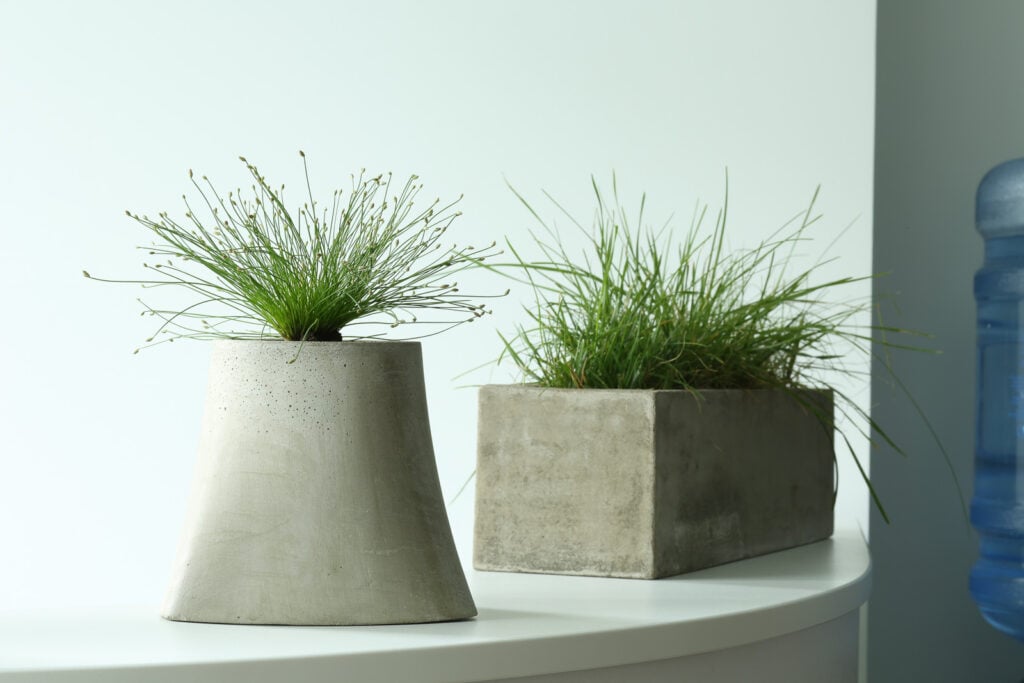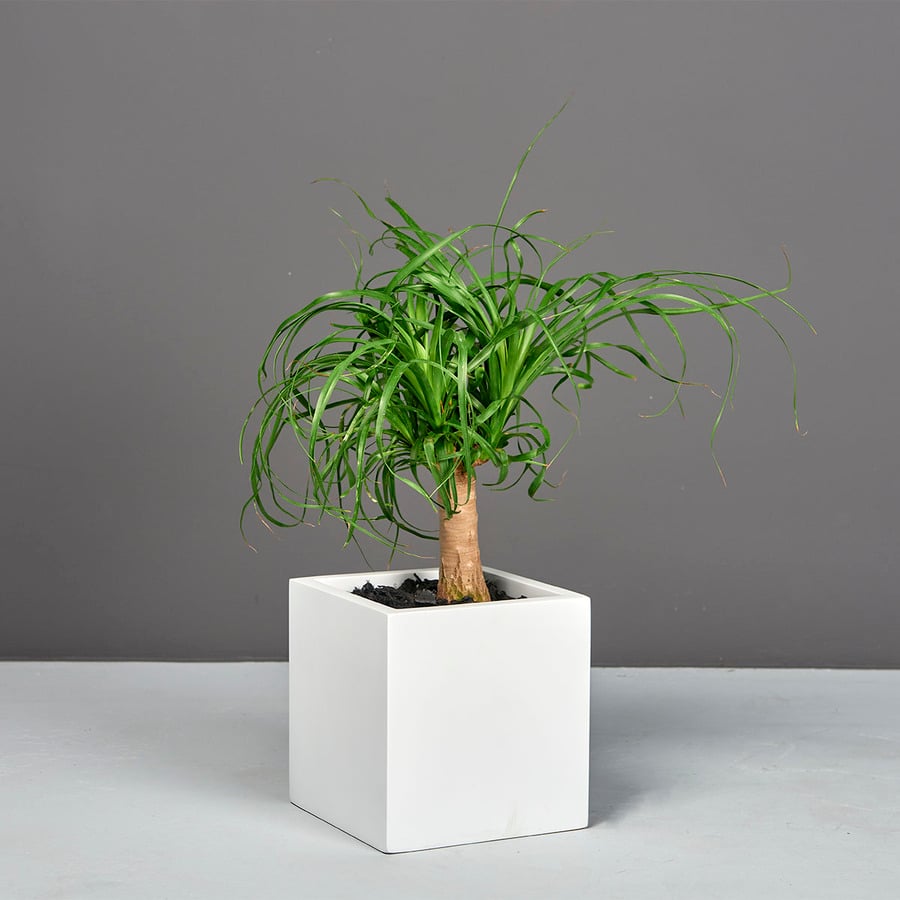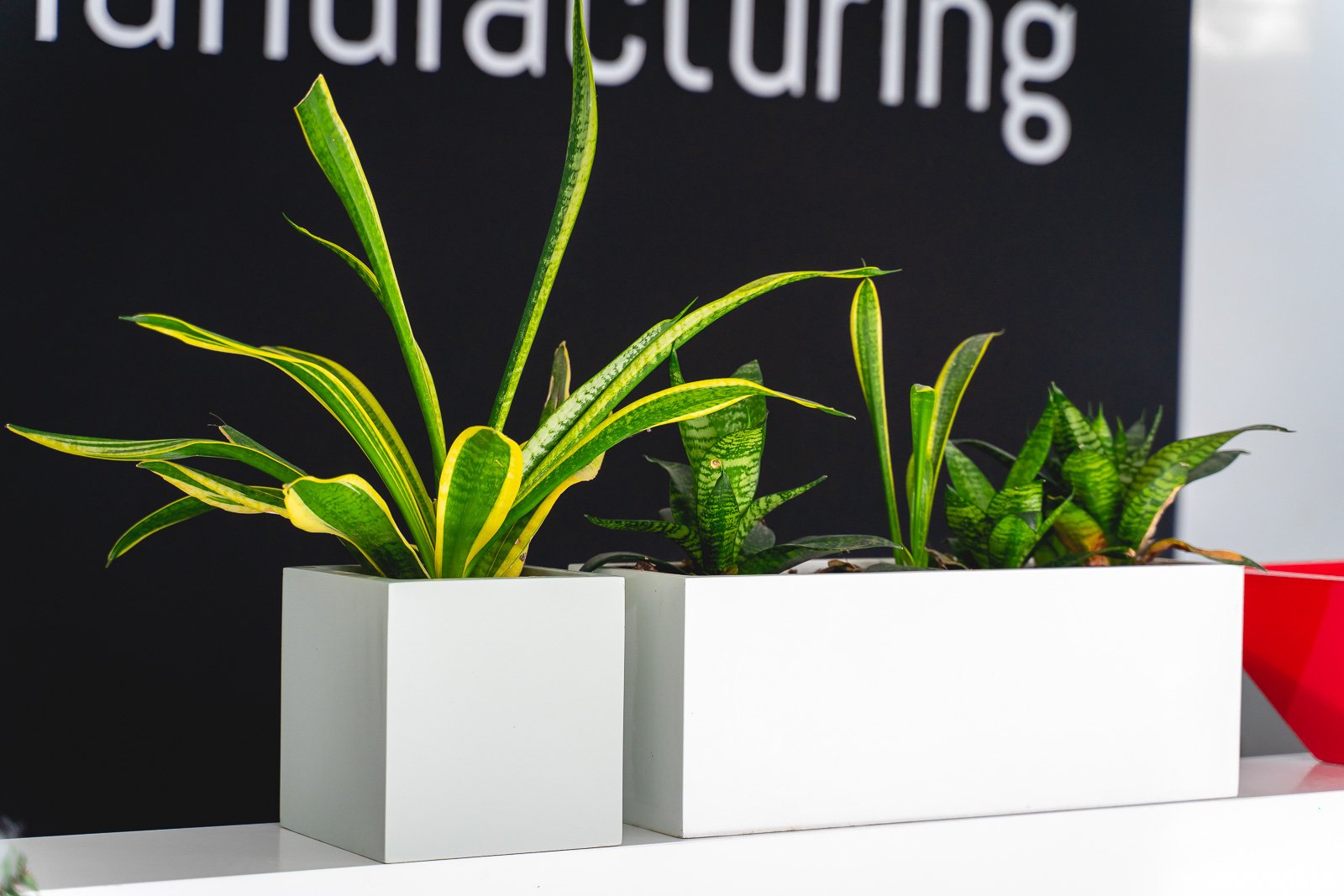Everybody’s heard of plastic planters – old news.
But what are composite containers?
Composite planters are made from a synthetic combination of stone, plastic, or glass fibers with a bonding agent – usual a natural resin.
The mixture is blended and molded into objects with limitless shapes and sizes. The result is a highly durable material that lasts much longer than traditional wood or plastic alone. However, flexibility in shape and durability are not the only advantages.
Due to their versatile appearance and low maintenance requirements, many commercial, government, and residential decision-makers choose composite planters to improve the aesthetic of their outdoor gardens, indoor lobbies, and public spaces while saving money on landscaping costs.
If you’re weighing up whether to invest in a traditional material, or to try something modern, here are 5 reasons why composite planter boxes are the best choice for you, your customers, and for both of your business interests.
5 Benefits Of Composite Planters
The versatility and durability of composite material has several logical and aesthetic benefits. Let’s look more closely.
1. Easy to customize style and shape

Composite planters are shaped using a mold that can be custom made to produce a line of unique products. Vietnam CDM have over 81 different shapes in our standard SKUs that have been designed to suit different applications from sleek modern to corporate simplicity.
Composite planters can be designed to any specification you can imagine meaning the skies are the limit!
Check out our custom planter services or contact us to see how we can make your planter dream come true.
2. Low maintenance
Once your planter is installed, upkeep is a breeze. Long gone are the days of cracks, you will never go back to other plant pots once you realize how much less time you spend worrying about repair and maintaining a professional landscaping display.
Composite planters (like our fiberglass planters) are often painted with a protective coating that seals the surface and adds more weatherproofing. The result is a product that lasts for years. The bottom line is that you spend far less money on replacing your display.
3. Improved drainage
Overwatering can make your plants susceptible to harmful fungal and bacterial growth. Especially in areas with heavy rain. Composite containers are easy to drill with new drainage holes. This can be done onsite or in our factory. Easily adding drainage holes will help your plants and flowers receive just enough water to keep them healthy.
The ease of doing it yourself means you can tailor each planter to needs of its plant. Your plants are getting too wet? Just put another hole in the bottom.
Related article: How To Water Commerical Planters
4. Protection From The Elements – Garden Displays All Year-Round

Most composite materials, including fiberglass and stone, are frost-proof and weather-resistant, making them ideal for outdoor gardens. Your composite planter box will not crack or rot, even as the changes in temperature expand and contract the soil inside your planter.
Plants grown directly in the ground or in metal or pure stone planters can get very cold, or very hot depending on the season. In the colder months, composite planter boxes will ensure that your foliage continues to grow properly. This is because your plants are more likely to thrive in the warmer, insulated, soil that composite planter boxes provide.
5. Durability

Your reputation, brand image, and future profits are all on the line with a less-than-perfect planter display, and yet not having such a display leaves your business looking life-less and cold, trailing behind the rest in the public eye.
The solution is composite planters. With many factories like ourselves utilizing a fully hand-made production process, any imperfections that will cause defects in appearance are identified and removed.
Once the planter has been molded, coated in a wear-and-tear protective layer, and leaves the factory, there is very little that will affect the structural or aesthetic performance of the planter for years to come.
These are the benefits, but how do you know what size planter to choose? Check out our guide to the best standard and custom sizes for your plants.
3 Types Of Composite Planters
By definition, a composite planter box must contain a blend at least two basic materials, such as wood, plastic, glass, metal, or stone and a binding agent like resin. Manufacturers are always experimenting with different combinations to find the most resistant and durable planter box, so it can sometimes be difficult to know exactly what you are getting when you buy branded planters.
Depending on the original materials, these planter boxes can have a smooth and glossy finish, or appear more weathered and rustic.
Another big variable between the different types of composite planters is the weight. Composites with lightweight materials like glass and plastic will be easier to move around than composites with heavier materials, such as stone.
Resin – The Long-Lasting Secret Ingredient

Resin is a strong and lightweight material made from plastic or, in our case, from non-plastic linear low-density polyethylene (LLDP). Using LLDP resin in the production process has many benefits for both the customer and their plants.
We use this high grade and eco-friendly ingredient to bind composites like fiberglass to form a flawless planter – strong, flexible, lightweight, and with a surface that exudes professionalism.
Although it is commonly mistaken for regular plastic, these planters are made from low-density polyethylene, which is much more durable and resistant to rot.
In terms of aesthetics, resin is one of the most versatile materials. Depending on your visual preferences, resin can be made to look like shiny plastic or textured concrete.
Since resin is made from recycled materials, the manufacturing process is considered to be eco-friendly. As a company that focuses on sustainability, our resin is sourced from within Vietnam and is certified as safe for both humans and plants.
GFRC

Glass fiber reinforced concrete, or GFRC, is a wonderful eco-friendly option for your garden. This is because it takes less energy to manufacture than other materials and is made from relatively-sustainable materials
Since GFRC is strong, its panels are usually thin. Therefore it has a much lighter weight than planters made of concrete alone.
The glass components can give the material a more sleek, modern look that will appeal to many gardeners, while the concrete provides strength and durability. Some manufacturers will add more concrete to the planter to reduce costs which in turn adds weight.
The downsides are that these containers can still be quite heavy when molded into large planters. Though this composite technique using concrete does create a relatively smooth looking planter, there are often still many imperfections on the outer surface, which can suit some rustic applications.
Fiberstone

Fiberstone (also known as fiber stone) outdoor planters are another great choice for outdoor gardens. Visually, this material does not have the same level of gloss finish as GFRC planters, so if you prefer a more textured aesthetic, fiberstone might be the right planter box for you.
Along with stone and fiberglass, materials such as sand and clay are also used to add weight and strength to the planter. While these planters are just as strong as GFRC, be careful because the larger the size, the harder it is to move these planters around.
Like other composite planters, they can handle temperature variances and inclement weather conditions without corroding or cracking. But due to the presence of heavy stone, if you plan to move your large planter inside in the winter months or make the occasional re-arrangement, you might want to choose a more lightweight material, like fiberglass.
Fiberglass

Our favorite composite planter boxes are made with fiberglass. This material is made from spun glass fiber which is reinforced with resin. It is an extremely lightweight and versatile material.
There are so many advantages to keeping your flowers in fiberglass outdoor planters. Like other composite materials, they are durable and you will never have to worry about rot or rust, even as the weather changes from season to season.
However, unlike other composite planter boxes made from stone, fiberglass planters are less likely to produce fissures in freezing weather and therefore can maintain a flawless finish.
In addition, having a lack of stone composites also makes fiberglass planters much less absorbant of extremely hot temperatures and thus plants have more protection in summer too.
Because of their lighter weight, fiberglass planters are easy to move around, but care must be taken in severe weather so they do not fall over with a gust of wind. Adding rocks and potting soil to the bottom of your planter (as you normally would with any planter) is one easy solution to this problem.
Fiberglass is also available in a wide range of styles due to the versatility of fiberglass material. New molds are easily created to meet the demand of ever-changing consumer trends. Likewise, these planter boxes can be painted to match any color scheme or aesthetic.
See how fiberglass competes with traditional materials in our planter material comparison guide.

Final Thoughts

Whether it’s a backyard patio or a rooftop garden, fiberglass is undoubtedly the best choice for your composite planter box. The durability and resistance to cracking and corrosion will ensure that your planter lasts for many years, regardless of temperature changes or general wear-and-tear. It is the lightest composite and the most professional-looking material too.
Our fiberglass pots are available in an extensive range of colors and sizes that are sure to beautify any outdoor space. Though each planter is hand-crafted and inspected rigorously for quality control, we ship our fiberglass planters with a 3-year warranty to emphasize the commitment and value of our products.
Many customers swear by composite outdoor planters for their private deck, restaurant patio, or even their corporate campus because they require almost zero maintenance and also improve the overall health and wellness of your plants over time.
Composite planters also really shine when used for indoor commercial applications due to their innately durable and lightweight nature, professionally painted appearance, and flexible style and design.
In fact, our composite planters are behind some of the most well-known brands in the USA and America. Learn more about our distribution partners.
What is your biggest problem right now with sourcing planters? We’d love to hear from you.
Send us a message to get your answers fast. Or, in the meantime, browse our inventory of standard fiberglass planters (p.s. we offer custom planters too!)
